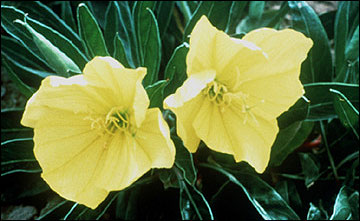From Wildflowers in the Home Landscape, University of Missouri Extension Sheet g6660

The Missouri primrose is a native wildflower well adapted to home landscapes. Photo courtesy of University of Missouri Extension.
Woodland wildflowers have these basic needs: light shade, adequate moisture, soil high in organic matter, well-drained soil, and a leaf mulch or other organic mulch that persists throughout the year.
Shade – Most woodland wildflowers do not grow in dense shade. They are at their most attractive in light shade, which in nature tends to be near the edge of the forest or under tall trees with high branching. The more limited the moisture supply, the more important is the shade during the heat of the day for good growth and survival. Some woodland wildflowers that flower in early spring become dormant by midsummer and will not be seen again until next season. These often grow before a dense canopy of leaves develops and can be used in more heavily shaded locations.
Moisture – Many native wildflowers are able to sustain considerable drying. However, others such as trillium, jack-in-the-pulpit and mayapple will grow and develop best where there is adequate moisture, particularly while they are growing rapidly or flowering. These plants also will go dormant in midsummer when dry conditions develop. Tree roots can be very competitive for moisture, so be prepared to give them some additional moisture, particularly during establishment or drought periods.
Soil – Wildflowers are adapted to certain native soils and normally can endure in conditions similar to the ones in which they grow in the wild. In the case of woodland wildflowers, organic matter is quite important. They normally grow in locations where leaves and other plant debris accumulates and becomes a part of their soil environment and a mulch. Organic matter helps hold moisture and helps soil stay loose and well-aerated. Liberal amounts of organic matter should be added to prepare woodland wildflower gardens. Leaf compost is particularly suitable.
Most woodland wildflowers need well-drained soil, but there are those that grow along creeks in wooded areas that tolerate or may need wetter conditions. Cardinal flower, jewelweed and forget-me-not are prime examples of this group, but it is best to know individual plant needs to fit them into the proper soil moisture requirement. The tables briefly indicate whether a plant needs wet, moist or relatively dry conditions to survive best.
Acidity – Wildflowers that thrive inMissourigenerally can be expected to need soil that is somewhat acid. Most plants listed will grow best in a pH range from about 5.5 to 6.2. However, most wildflowers are adaptable and are tolerant of an even wider pH range. It usually is not necessary to lime soils that are to be used for wildflowers unless the native soil is unusually acid. A soil test to determine existing soil conditions is important in starting wildflowers in a new location where wildflowers may not have been grown previously.
Mulch -Woodlandwildflowers should not be grown in bare soil as is often done with popular garden flowers. They need a mulch or the protection of another low-growing, noncompetitive plant nearby. Mulches keep soil cooler, maintain more uniform moisture and aid in winter protection. Oak leaves are a very durable and suitable mulch for many of them, although most woodland wildflowers will benefit from a mulch of any type of leaf cover.
Read the full article.
From Wikipedia: The Cooperative Extension Service, also known as the Extension Service of the USDA, is a non-formal educational program implemented in the United States designed to help people use research-based knowledge to improve their lives. The service is provided by the state’s designated land-grant universities. In most states the educational offerings are in the areas of agriculture and food, home and family, the environment, community economic development, and youth and 4-H.
Editor’s Note: The Missouri Extension Service has hundreds of publications on a wide variety of subjects. Many of them are four page pamphlets, some are shorter and some are book length. Many of the book length ones can only be purchased, but the short ones are free if you download them (in PDF format). Actually you pay for them with your taxes, so take a look and get your money’s worth: http://extension.missouri.edu.

